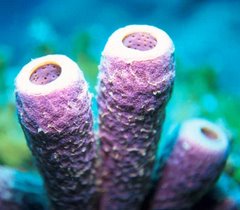
Most assortments of adult sponges are sessile and are commonly fastened to surfaces. Often one can spot these animals on hard exteriors such as rocks on the ocean floor. Some however are competent in creating a root-like base and can attach itself to soft sediment. Although not all Poriferan have been recorded to do so, many species have been recognized in their ability to move at extremely slow speeds. Commonly, sponges tend to rely on water currents for movement.
Being sessile creatures can come with its advantages and it can danger the animal substantially. Less energy is spent on movement, and resources are spent on growth and reproduction. Sessile tide pool organisms take advantage of the movement of the water around them and the water brings food, oxygen, and gametes from other animals. Strong holding mechanisms help them avoid being swept away by the tide, which can allow the animal to adapt to its environment well. As for the dangers of being sessile, predators can easily approach and attack porifera which often contributes to shortages in sponge population.


1 comment:
The photo shows a mollusc, Cyphoma gibbosum, not a sponge.
Post a Comment